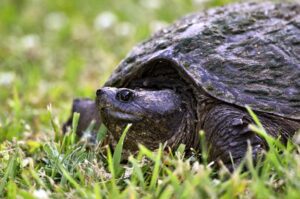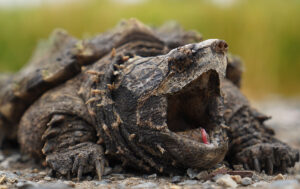Prepare to be amazed by a compilation of captivating insights into the world of snapping turtles. These ancient reptiles hold a myriad of surprises, from their powerful jaws to their remarkable ability to adapt.
On this page we will explore the depths of their habitats and unravel the mysteries behind their fascinating behaviors. Get ready for a journey filled with intriguing revelations and discover the truly ‘interesting facts about snapping turtles‘
Importance of snapping turtles in ecosystems

Snapping turtles play crucial roles in their ecosystems, contributing to the balance and health of aquatic environments in various ways:
- Predator-Prey Dynamics: Snapping turtles help regulate populations of their prey, such as small fish, amphibians, insects, and even carrion. By keeping these populations in check, they prevent any one species from dominating and disrupting the ecosystem’s balance.
- Scavengers: These turtles are opportunistic feeders, consuming both live prey and carrion. By scavenging on dead animals, they help to clean up the environment, preventing the spread of disease and recycling nutrients back into the ecosystem.
- Habitat Engineering: Snapping turtles are known to create and modify habitats. They dig nests for laying eggs, which can inadvertently create burrows that serve as shelters for other species. Additionally, their foraging behavior can stir up sediment, which can improve water quality and increase nutrient availability for other organisms.
- Indicator Species: As long-lived animals at the top of the food chain, snapping turtles can serve as indicators of ecosystem health. Their population trends and health can reflect changes in water quality, habitat availability, and the overall condition of aquatic ecosystems.
- Seed Dispersal: Snapping turtles have been observed consuming fruits and seeds, particularly those that fall into the water. By doing so, they can aid in the dispersal of seeds, contributing to the diversity and distribution of plant species within their habitats.
- Biological Control: In some cases, snapping turtles may help control invasive species. For example, they have been documented preying on invasive species such as certain types of fish or crayfish, which can help mitigate the negative impacts of these invaders on native ecosystems.
Overall, snapping turtles are integral components of aquatic ecosystems, influencing various ecological processes and contributing to the overall biodiversity and stability of their habitats. Protecting these turtles is not only important for their own conservation but also for the health and resilience of the ecosystems they inhabit.
59 Interesting facts about snapping turtles
Snapping turtles are fascinating creatures! Here are 59 interesting facts about them:
- Snapping turtles belong to the family Chelydridae.
- There are two species of snapping turtles: the common snapping turtle (Chelydra serpentina) and the alligator snapping turtle (Macrochelys temminckii).
- The common snapping turtle is found throughout North America, while the alligator snapping turtle is native to the southeastern United States.
- Snapping turtles are known for their large, powerful jaws and aggressive behavior.
- Despite their fierce reputation, snapping turtles are actually quite shy and will typically try to avoid confrontation with humans.
- Snapping turtles have long, flexible necks that can extend quickly to snap at prey or defend themselves.
- The shell of a snapping turtle is composed of bony plates covered by tough, keratinized skin.
- The shell of a snapping turtle can vary in color from olive green to dark brown, depending on the environment.
- Snapping turtles are primarily aquatic but will venture onto land to bask in the sun or lay eggs.
- They are most commonly found in freshwater habitats such as ponds, lakes, rivers, and marshes.
- Snapping turtles are opportunistic feeders and will eat a wide variety of prey, including fish, frogs, snakes, insects, and even small mammals.
- They are also scavengers and will consume carrion and other dead organisms.
- Alligator snapping turtles are the largest freshwater turtles in North America, with some individuals reaching weights of over 200 pounds (90 kilograms).
- The alligator snapping turtle gets its name from its distinctive hooked beak, which resembles that of an alligator.
- Despite their size, alligator snapping turtles are relatively docile and are not typically aggressive towards humans unless provoked.
- Female snapping turtles are larger than males, with longer tails and wider shells.
- Snapping turtles are capable of living for several decades in the wild, with some individuals reaching ages of 50 years or more.
- They are ectothermic, meaning their body temperature is regulated by their environment.
- Snapping turtles are primarily nocturnal, meaning they are most active at night.
- During the day, snapping turtles will often bury themselves in the mud or seek shelter under submerged logs or rocks.
- Snapping turtles are solitary animals and do not typically form social groups.
- During the breeding season, which typically occurs in the spring and early summer, male snapping turtles will search for females and may engage in combat with rival males.
- Female snapping turtles typically lay their eggs in sandy or gravelly soil, digging a nest with their hind legs and laying a clutch of eggs before covering them with soil and vegetation.
- The incubation period for snapping turtle eggs is typically 9-18 weeks, depending on temperature and other environmental factors.
- The sex of snapping turtle hatchlings is determined by the temperature at which the eggs are incubated, with warmer temperatures producing females and cooler temperatures producing males.
- Snapping turtle hatchlings are vulnerable to predation from a variety of predators, including raccoons, birds, fish, and larger turtles.
- Snapping turtles have powerful hind legs and webbed feet, which make them strong swimmers.
- Despite their aquatic abilities, snapping turtles are not particularly fast swimmers and rely on stealth and ambush to catch their prey.
- Snapping turtles have keen senses of smell and can detect the scent of food from long distances.
- They have small eyes located on the sides of their heads, which provide them with a wide field of vision.
- Snapping turtles have excellent underwater vision and can see well in dim light conditions.
- They have sensitive skin that can detect vibrations and changes in water pressure, allowing them to detect the presence of nearby prey or predators.
- Snapping turtles have a highly developed sense of touch, particularly in their head and neck regions, which they use to locate and capture prey.
- They have powerful muscles in their jaws and necks, which allow them to deliver a quick and forceful bite.
- Snapping turtles have a unique feeding strategy known as “lingual luring,” where they use their tongue to mimic the movements of a worm or other prey, attracting fish or other animals within striking range.
- Snapping turtles are capable of vocalizing, emitting hissing or grunting sounds when threatened or disturbed.
- They are generally not aggressive towards humans but will defend themselves if threatened or handled improperly.
- Snapping turtles are important members of their ecosystems, playing a role in controlling populations of prey species and serving as scavengers.
- They are also host to a variety of parasites, including flatworms, roundworms, and leeches.
- Snapping turtles have few natural predators as adults, but young turtles are vulnerable to predation from a variety of animals, including birds, mammals, and larger turtles.
- Snapping turtles are known to carry Salmonella bacteria, which can cause illness in humans if ingested or if contact is made with contaminated water or surfaces.
- They are protected by law in many areas due to concerns about overharvesting and habitat loss.
- Snapping turtles are sometimes kept as pets, although they require specialized care and can be challenging to keep in captivity.
- In some cultures, snapping turtles are considered a delicacy and are hunted for their meat and eggs.
- Snapping turtles play a role in traditional folklore and mythology in many Native American cultures, where they are often portrayed as wise and powerful creatures.
- The largest recorded common snapping turtle weighed 75 pounds (34 kilograms) and had a carapace length of 19.5 inches (49.5 centimeters).
- The largest recorded alligator snapping turtle weighed 249 pounds (113 kilograms) and had a carapace length of 31.5 inches (80 centimeters).
- Snapping turtles are capable of traveling long distances overland, particularly during the breeding season when they may need to move between different water bodies.
- They have been known to travel several miles over land, using their powerful limbs to push themselves forward.
- Snapping turtles are not territorial and will often share their habitat with other turtles, including individuals of the same species.
- They are capable of hibernating during the winter months, burrowing into the mud at the bottom of ponds or lakes to escape the cold temperatures.
- During hibernation, snapping turtles enter a state of torpor, where their metabolic rate decreases, and they become less active.
- Snapping turtles have a highly developed sense of smell, which they use to locate food, mates, and suitable nesting sites.
- They are capable of detecting chemical cues in the water and can distinguish between different odors.
- Snapping turtles have a relatively low reproductive rate, with females typically laying only one clutch of eggs per year.
- They have a long reproductive lifespan, with females capable of laying eggs for several decades.
- The mating ritual of snapping turtles can be violent, with males often biting and scratching females during courtship.
- Female snapping turtles may travel long distances to find suitable nesting sites, often returning to the same area year after year.
- Snapping turtles have a strong homing instinct and are capable of finding their way back to their home territory even after being moved long distances.


